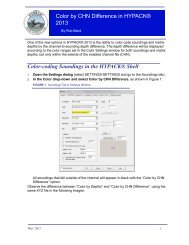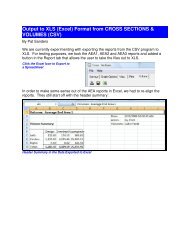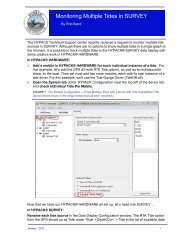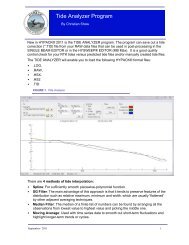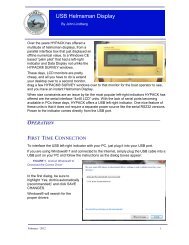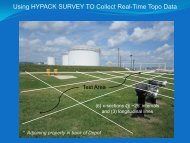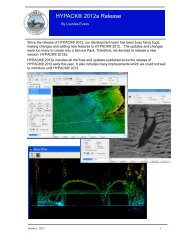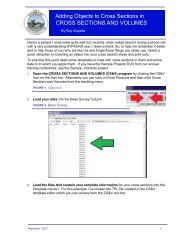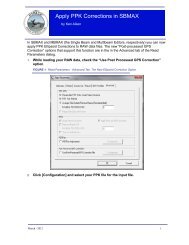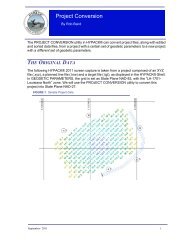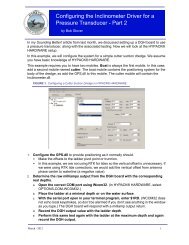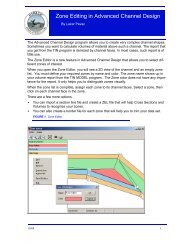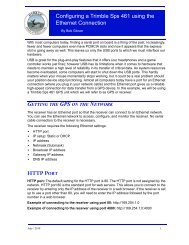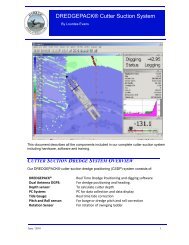Static and Dynamic Draft in HYPACK.fm
Static and Dynamic Draft in HYPACK.fm
Static and Dynamic Draft in HYPACK.fm
You also want an ePaper? Increase the reach of your titles
YUMPU automatically turns print PDFs into web optimized ePapers that Google loves.
of the vessel. The water <strong>in</strong> the stack can come from the water surround<strong>in</strong>g the vessel,<br />
result<strong>in</strong>g <strong>in</strong> a downward displacement of the vessel.<br />
FIGURE 12. <strong>Static</strong> <strong>Draft</strong> (left) vs <strong>Dynamic</strong> <strong>Draft</strong> (right)<br />
In Figure 12, the vessel on the left is ‘<strong>Static</strong>’ (not mov<strong>in</strong>g). We have determ<strong>in</strong>ed the <strong>Static</strong><br />
<strong>Draft</strong> is 1.0 m <strong>and</strong> the Depth Below Transducer is 19.0m. The same vessel on the right is<br />
underway <strong>and</strong> the transducer has descended 0.5m <strong>in</strong> the water column. The <strong>Static</strong> <strong>Draft</strong> is<br />
still 1.0m, the <strong>Dynamic</strong> <strong>Draft</strong> is 0.5m <strong>and</strong> the Depth Below Transducer is now 18.5. We’ll use<br />
these sett<strong>in</strong>gs <strong>in</strong> the next examples.<br />
In <strong>HYPACK</strong>®, F<strong>in</strong>al Depth = Raw Depth + <strong>Static</strong> <strong>Draft</strong> + <strong>Dynamic</strong> <strong>Draft</strong> (+ Tide, SV <strong>and</strong><br />
Heave corrections)<br />
• In the <strong>Static</strong> Case: F<strong>in</strong>al Depth = 19.0 + (1.0 + 0.0) = 20.0<br />
• In the <strong>Dynamic</strong> Case: F<strong>in</strong>al Depth = 18.5 + (1.0 + 0.5) = 20.0<br />
H OW TO D ETERM IN E TH E D YN AM IC D RAFT FO R YO U R<br />
SURVEY BOAT<br />
There are two practical methods for determ<strong>in</strong><strong>in</strong>g the <strong>Dynamic</strong> <strong>Draft</strong> for your vessel. Before<br />
mak<strong>in</strong>g that determ<strong>in</strong>ation, you should first correct for the <strong>Static</strong> <strong>Draft</strong>, by perform<strong>in</strong>g a bar<br />
check. You should also perform these measurements at slack tide, or make a note of the<br />
changes <strong>in</strong> the water level so they can be factored out of your test. We will need to determ<strong>in</strong>e<br />
the <strong>Dynamic</strong> <strong>Draft</strong> correction over a range of eng<strong>in</strong>e power sett<strong>in</strong>gs, as the correction can<br />
vary due to amount of power be<strong>in</strong>g applied.<br />
• Method 1: Use a Level Instrument.<br />
a. Set up a level <strong>in</strong>strument on the end of a pier.<br />
b. Have a crew member hold a stadia rod vertically above the transducer.<br />
c. Have the level operator make read<strong>in</strong>gs when the vessel is static <strong>and</strong> underway at<br />
different power sett<strong>in</strong>gs.<br />
Note: Try to make the read<strong>in</strong>g when the vessel is the same distance from the level<br />
<strong>in</strong>strument.<br />
September / 2010 7



